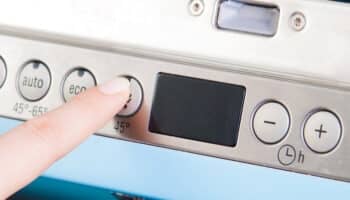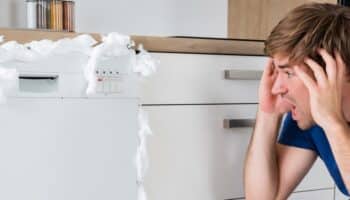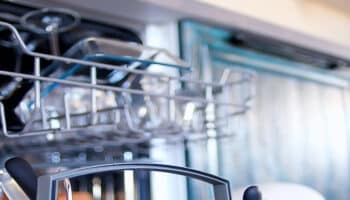Is your dishwasher not filling?
I’ve been there too! I understand how frustrating it can be when your dishwasher is not working as it should, especially when you have a pile of dirty dishes to wash.
The good news is that you’ve come to the right place to fix the issue.
If your dishwasher is not filling properly, you’ll need to check the water valve and replace it if necessary. If the issue persists, it’s important to examine the float assembly, door switch, or main control board.
Read on to get your dishwasher working again!
Fixing a Dishwasher That’s Not Filling Properly: 5 Steps
If your dishwasher is not filling with water properly, there’s probably an issue with the water inlet valve. Don’t worry, though. In this section, I’ll walk you through the five steps you must follow to solve the issue.
Keep in mind that fixing the problem will require accessing and removing certain internal components, so it’s crucial you have the owner’s manual handy.
Can’t find your manual? No problem! Click the link below to find it!
Are you ready? Let’s dive in!
#1 Check the Water Supply
Inspecting the water valve when a dishwasher is not filling properly is crucial, but so is checking the water supply.
If there isn’t enough water or the supply is interrupted, your dishwasher won’t fill properly. Therefore, it’s essential to make sure the water supply valve, typically located under the kitchen sink, is fully open.
If the water supply valve is open, please inspect the hose that connects your dishwasher to the home’s water supply. To do so, place a towel underneath and carefully disconnect the hose. Then, clear any obstructions that could be restricting water flow.
If you find that the water supply hose is cracked, kinked, or severely damaged, you should purchase a compatible replacement.
While you’re at it, please check the water pressure in your home by turning on other faucets. If the water pressure seems too low, you should call a professional, as your home probably has an underlying plumbing issue.
Tip: Avoid using other appliances that require water while your dishwasher is running to prevent water flow issues.
#2 Examine the Water Valve
I find that when a dishwasher is not filling properly, it’s typically due to a malfunctioning water valve.
The water valve is one of the most important components in your dishwasher, as it opens to allow water to flow into the unit. Once your dishwasher has filled with water, the valve closes to prevent leaks or potential overflowing problems.
Unfortunately, if there’s an issue with the water valve, your dishwasher won’t fill at all, will fill too slowly, or could even overflow.

Testing the water valve is very simple; you’ll just need to:
- Unplug your dishwasher from its power source or turn it off at the circuit breaker.
- Remove the kickplate using a screwdriver and access the water inlet valve.
- Inspect the water valve for any visible signs of damage.
- Carefully disconnect the wires from the valve coil terminals.
- Set your multimeter to the ohms or resistance setting. Then, place one of the meter’s probes on one terminal of the valve and the other probe on the other terminal.
- The multimeter should display a reading between 500 and 1500 ohms of resistance (or the one recommended by the manufacturer).
If you notice the water valve is damaged, or the multimeter’s needle or display doesn’t change significantly, you’ll need to replace it with a new one.
Tip: To ensure the water valve you purchase is compatible, search for your dishwasher’s model number and enter it in the search bar below.
Keep in mind that if you’re not experienced with DIY tasks or don’t feel comfortable testing and replacing dishwasher components, it’s best to call a professional. They have the required tools and expertise to diagnose and fix the issue.
#3 Examine the Float Assembly
If you’ve replaced the water valve, but your dishwasher is still not filling properly, then there’s probably an issue with the float assembly.
The float assembly consists of a switch and a floating device that are responsible for sensing and controlling the water level. As your dishwasher fills, the float rises along with the water. Once it reaches the desired level, it signals the switch to shut off the inlet valve, preventing any more water from entering.
If the float assembly is stuck or malfunctioning, it won’t accurately detect the water level. As a result, it can think that the dishwasher is already full, even when it’s not.
To fix the issue, you’ll need to access the float, which is a small plastic device found at the bottom of the dishwasher. Then, gently lift the float up and down.
If the float is stuck due to debris or detergent residue, clean underneath or around it using a soft brush or sponge. However, if the float isn’t stuck, I recommend testing the switch with a multimeter.
Keep in mind that the process of accessing the float switch can vary depending on your dishwasher’s model, so please refer to the manufacturer’s manual for detailed instructions.
The float switch should show continuity when you press the button down. If the multimeter doesn’t indicate continuity, you’ll need to replace the switch with a new, compatible one.
#4 Check the Door Switch
When fixing a dishwasher that’s not filling properly, my usual advice is to check the door switch.
The door switch is a safety device that detects when the door is open or closed to stop the cycle accordingly. If the switch malfunctions, it can think that the door is open, even when it’s not, and keep your dishwasher from filling with water.
Unplug your dishwasher and refer to the manufacturer’s manual to access the door switch. To test the switch, simply place one of the multimeter’s probes on one of its terminals and the other probe on the remaining terminal. Then, press the button on the switch and check the multimeter reading.
If the switch lacks continuity, it will need to be replaced. Here’s how:
- Unplug your dishwasher from the power outlet or turn it off at the circuit breaker.
- Remove the necessary components to access the dishwasher’s console. Then, locate the door switch.
- Remove the screws that are holding the faulty door switch in place.
- Carefully disconnect the wires and pull the door switch out.
- Install the new switch.
- Reassemble your dishwasher.
Once you’ve replaced the door switch, please turn your dishwasher back on and run a wash cycle.
#5 Inspect the Control Board
The last possible reason why your dishwasher is not filling properly is a malfunctioning control board.
You can think of the control board as your dishwasher’s brain. It manages all the internal components and ensures they work together for the best cleaning results. If the control board malfunctions, it won’t send the necessary signals to the water inlet valve, preventing water from entering the unit.
Unfortunately, replacing the control board can be both expensive and challenging. Therefore, I recommend consulting your warranty status. If your dishwasher is no longer under warranty or is over ten years old, replacing the entire appliance is often more cost-effective.
Wrapping Up: Ensuring Proper Dishwasher Water Fill
Hopefully, now you know how to fix your dishwasher’s issues.
Remember that if your dishwasher is not filling properly, you’ll need to make sure the water supply valve is fully open. If it is, test the water inlet valve with a multimeter and replace it if necessary. If the issue persists, don’t forget to examine the float assembly, door switch, and control board.
Thank you so much for taking the time to read this article. If you’ve found it helpful, please check out our other related posts below.
Have a great rest of the day!










